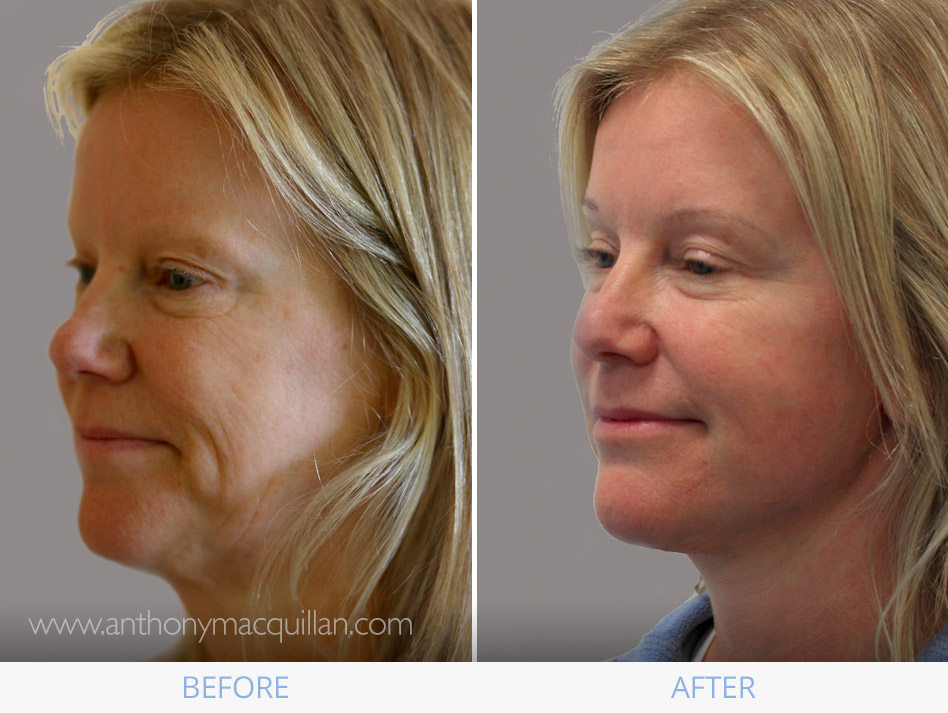What to Expect from Facelift Scars after Your Procedure
You’re considering a Facelift surgery, a procedure that promises to rejuvenate your appearance, restore your youthful vibrancy, and boost your self-confidence. But like any surgical procedure, it comes with its own set of challenges and concerns. One of the most common concerns is scarring. Understanding what to expect can help you prepare for the procedure and manage your expectations realistically.
In this blog, Consultant Plastic Surgeon Anthony MacQuillan aims to provide in-depth information about facelift scars, from their formation to their reduction, and everything in between.
The journey towards a younger-looking you begins with a single decision, but it doesn’t end there. The road to recovery and complete healing is a significant part of the process.
What Are Facelift Scars?
Facelift scars are a natural consequence of Facelift surgery. They are the body’s response to the incisions made during the procedure. Your body produces collagen, a protein that helps repair the skin, leading to the formation of scar tissue.
The appearance of your Facelift scars can vary depending on several factors. These include your skin type, age, the surgical technique used, and your body’s healing process. They can appear as thin, flat lines or may have a more noticeable appearance.
It’s crucial to remember that while scars are a natural part of the healing process, their visibility after your Facelift procedure can be minimised with the right care and treatment.
What Causes the Scars?
Understanding what causes Facelift scars can help you come to terms with them. During your Facelift procedure, Anthony makes incisions to remove excess skin and tighten the underlying tissues. These incisions are usually made along the hairline or within the natural contours of the face to minimise visibility.
Despite Anthony’s best efforts, these incisions can leave behind scars. However, the scars from a Facelift surgery are usually well concealed and can fade over time with proper care.
The extent and visibility of your facelift scars also depend on the specific technique used during the surgery. Some techniques may result in more extensive scarring than others. Discussing these specifics with Anthony before the procedure can help set realistic expectations.
What to Expect in Terms of Facelift Scars
Post-surgery, you can expect to see some degree of scarring. Initially, your scars may appear red and swollen. This is a normal part of the healing process and should not cause undue concern.
Over time, Facelift scars will gradually fade and become less noticeable. The speed and degree of this improvement can vary depending on individual factors such as your skin type, age, and overall health.
It’s important to remember that while facelift scars do fade, they never completely disappear. However, with proper care and treatment, they can be made less noticeable and more easily concealed.
How to Minimise Scars after Facelift
There are several ways you can help minimise the appearance of Facelift scars. First and foremost, it’s essential to follow Anthony’s post-operative care instructions. This may include instructions on cleaning the incision area, applying topical treatments, and avoiding sun exposure.
In addition to following your surgeon’s instructions, there are several treatments available that can help reduce the appearance of Facelift scars. These include silicone sheets or gels, which can help flatten and soften scars, and corticosteroid injections, which can help reduce inflammation and prevent excessive scar tissue formation.
Regularly applying a broad-spectrum sunscreen can also help protect your scars from the sun’s harmful UV rays, which can darken scars and make them more noticeable.
Timeline of Facelift Scar Reduction
The healing process following a Facelift is a complex and gradual journey, particularly when it comes to scar reduction. Understanding the typical timeline can help set realistic expectations and provide reassurance throughout the recovery period.
- Immediate Post-Operative Period (First 1-2 Weeks): Right after the surgery, scars are usually at their most noticeable. They can appear red, raised, and even slightly swollen. This is a normal part of the body’s healing response. During this period, it’s crucial to follow all post-operative care instructions to ensure optimal healing and reduce the risk of infection.
- Early Healing Phase (2 Weeks to 1 Month): As the initial weeks pass, you’ll start to notice the redness and swelling around the scars diminishing. The body is actively healing, and the scars begin to settle down. They might still be quite visible, but this is a normal stage in the scar maturation process.
- Intermediate Phase (1-3 Months): During this phase, the scars often start to change colour, transitioning from red to a more pink or purple hue. They will gradually become less raised. This is a good sign that your body is healing as expected. It’s important to continue protecting the scars from sun exposure during this phase to prevent hyperpigmentation.
- Late Healing Phase (3-6 Months): By this time, significant improvements are usually visible. The scars should be less conspicuous, flatter, and lighter in colour. They may start blending more with the surrounding skin. However, they are still maturing and changing.
- One Year Mark: Around one year after your facelift, you’ll likely notice a substantial improvement in the appearance of your scars. They should be much less noticeable, having faded significantly and flattened out. For many people, this is the point where they feel more confident about the results of their surgery.
- Full Maturation (1-2 Years): The complete healing process can take up to two years. By this time, the scars should have matured fully, meaning they have reached their final state in terms of colour, texture, and elevation. They are typically much less visible than they were in the months following the surgery.
Professional Treatments for Facelift Scars
If you’re unsatisfied with the appearance of your Facelift scars after giving them sufficient time to heal, there are professional treatments available that can help. These include laser treatments, which can help reduce the redness, thickness, and length of scars, and dermabrasion, which can help smooth the surface of scars.
Before opting for any professional treatment, it’s essential to discuss your options with Anthony. He can help you understand the potential risks and benefits and guide you in making an informed decision.
Are Facelift Scars Permanent?
The truth is, Facelift scars are permanent. They are a natural part of the body’s healing process following surgery. However, with time and the right care, they can become less noticeable.
Remember, the goal of a Facelift is not to achieve perfection, but improvement. It’s about feeling better in your skin and boosting your confidence.
So, while Facelift scars are a reality, they shouldn’t deter you from pursuing your desire for a rejuvenated appearance. With the right mindset, preparation, and care, you can navigate the healing process and embrace your new look with confidence.
Facing the facts about Facelift scars can help you make an informed decision about whether the procedure is right for you. If you’re considering a Facelift, be sure to discuss your concerns about scarring with Anthony. He can provide you with further information and guidance based on your individual circumstances and goals.
FAQs about Facelift Scars
Where are Facelift scars located?
- Facelift scars are located around the hairline, behind the ears, and possibly under the chin, depending on the extent of the surgery. The exact location can vary based on the specific techniques used by the plastic surgeon.
How noticeable are Facelift scars?
- The visibility of Facelift scars can vary. Skilled surgeons usually make incisions along natural skin creases or areas that can be hidden by hair, making them less noticeable. Over time, these scars often fade and become even less visible.
What factors affect the healing of Facelift scars?
- Several factors can affect the healing of Facelift scars, including the patient’s age, skin type, genetics, lifestyle choices (such as smoking), and the surgeon’s skill in minimising and placing the incisions.
Can Facelift scars be completely eliminated?
- While Facelift scars cannot be completely eliminated, they can be significantly minimised and made less noticeable. Proper post-operative care and time allow the scars to fade considerably.
How long does it take for Facelift scars to heal?
- The initial healing phase for Facelift scars typically takes a few weeks, but it can take several months to a year for the scars to mature fully and fade as much as possible.
Are there treatments to improve the appearance of Facelift scars?
- Yes, there are several treatments available to improve the appearance of Facelift scars, including silicone gel sheets, steroid injections, laser therapy, and sometimes revision surgery in more pronounced cases.
How can I ensure the best healing of my Facelift scars?
- Following your plastic surgeon’s post-operative instructions is crucial for the best healing. This includes avoiding direct sun exposure, not smoking, maintaining a healthy diet, and possibly using recommended scar treatment products.
Do Facelift scars differ in men and women?
- The basic nature of Facelift scars is similar in both men and women, but the placement and management might differ slightly due to differences in hairline, beard growth, and skin texture.
Can a Facelift be done without any scars?
- All Facelifts involve some degree of scarring since incisions are necessary for the procedure. However, modern techniques aim to minimise and conceal scars as much as possible. Non-surgical Facelift alternatives may offer results with no scarring, but these are generally less dramatic and not long-lasting compared to surgical facelifts.
Further Reading about Face Procedures with Anthony MacQuillan
- Facelift Surgery
- Ear Correction Surgery
- Eyelid Surgery
- Visible Effects of Ageing That Can Be Improved With a Facelift
- Tips to Sleep Better After Facelift Surgery



